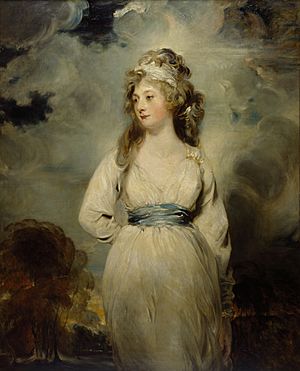Amelia Stewart, Viscountess Castlereagh facts for kids

Amelia Anne "Emily" Stewart, Marchioness of Londonderry (born February 20, 1772 – died February 12, 1829), was an important woman in British society during the Regency era. From 1794 to 1821, she was known as Lady Castlereagh. She was married to Robert Stewart, Viscount Castlereagh, a powerful Irish politician.
Her husband was the British Foreign Secretary (like a top diplomat) from 1812 to 1822. He was also the Leader of the House of Commons. Because of her family connections and her husband's important job, Lady Castlereagh was a very influential person in London's high society.
Contents
Her Family Background
Emily Hobart, as she was known before marriage, came from a well-known family. Her father was John Hobart, 2nd Earl of Buckinghamshire. He was an English politician and worked for the royal court. He served as the British Ambassador to Russia and later as the Lord Lieutenant of Ireland.
Her mother, Caroline Conolly, also came from a very wealthy family. Caroline's uncle, William Conolly, was a powerful landowner in Ireland. Emily's uncle, Thomas Conolly, was a famous sportsman. He was married to Lady Louisa Conolly, who was one of the famous Lennox sisters.
Her Marriage and Life
In 1794, Emily Hobart married Robert Stewart. He was the son of another important Irish politician, Robert Stewart, 1st Marquess of Londonderry. After 1796, her husband was known by his special title, Viscount Castlereagh. In 1821, he became the 2nd Marquess of Londonderry.
Emily and Robert were a very loving couple. They did not have any children of their own. However, they helped care for Frederick Stewart when his father, Robert's half-brother, was away serving in the British Army. Emily loved to travel and was always ready to go with her husband on his trips abroad. This made her a great wife for a diplomat.
Her Later Years
After her husband passed away, Emily lived quietly in the countryside for almost two years. In 1824, she started to return to her social life. Some of her husband's friends thought this was too soon. However, her health soon began to fail, and she died in 1829.
A Leader in Society
During the Regency era in London, Lady Castlereagh was a very important social leader. She was one of the "Lady Patronesses" of Almack's. This was one of the first and most exclusive social clubs in London.
As a Patroness, she had a lot of power. She decided who could get "vouchers" (tickets) to Almack's. This meant she helped set the rules for London's social elite. She decided who was accepted into the highest levels of society.
Lady Castlereagh is known for bringing the quadrille dance to London. She was also famous for closing Almack's doors strictly at eleven o'clock. She even once turned away the famous Arthur Wellesley, 1st Duke of Wellington because he was late! People sometimes found her own parties a bit boring. They also said she talked a lot about small things in a strange, distant way.
Her Private Zoo
At her country home, Loring Hall, Lady Castlereagh had her own private zoo. It was home to many interesting animals. These included antelopes, ostriches, kangaroos, and even a tiger that was known for being quite grumpy!
Lady Castlereagh is often mentioned in Regency novels. She appears most famously in the historical romance novels by Georgette Heyer.

